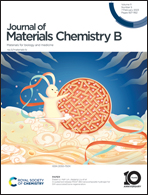Investigation of the role of pH and the stoichiometry of the N-dopant in the luminescence, composition and synthesis yield of carbon dots†
Abstract
Carbon dots (CDs) are carbon-based nanoparticles with very attractive luminescence features, which simplicity and flexibility of their fabrication can lead to an endless number of CDs with distinct properties and applications. High fluorescence quantum yields (QYFL) are generally a necessary feature for various applications of CDs. One commonly employed strategy to improve the fluorescence properties of CDs is heteroatom-doping using precursors containing desired heteroatoms (with focus on N-doping). In this work, we report the synthesis and systematic investigation of an array of N-doped CDs, obtained from the dry heating of solid mixtures of glucose and urea in different molar ratios with two main objectives: to study the role of stoichiometry in the optical properties and composition of CDs and to investigate the formation of possible alkaline-responsive nanoparticles and the potential of this procedure for obtaining CDs with higher synthesis yields. We have characterized the optical properties of this diverse array of glucose and urea-based CDs using both UV-Vis and fluorescence spectroscopies. In addition, we have also examined the CDs by using high-resolution transmission electron microscopy (HR-TEM) and X-Ray photoelectron (XPS) spectroscopy, as well as by assessing the thermal stability of the nanoparticles. We have found that this fabrication process generates two types of CDs, one readily soluble in water and other only soluble at basic pH. The latter was characterized by higher synthesis yields, and lower QYFL and thermal stability, when compared with those of the former. Furthermore, the stoichiometry of the N-dopant does not appear to be correlated with the QYFL of the obtained CDs. This study provides novel information that should be useful for the future rational development of CDs with higher QYFL and synthesis yields.



 Please wait while we load your content...
Please wait while we load your content...